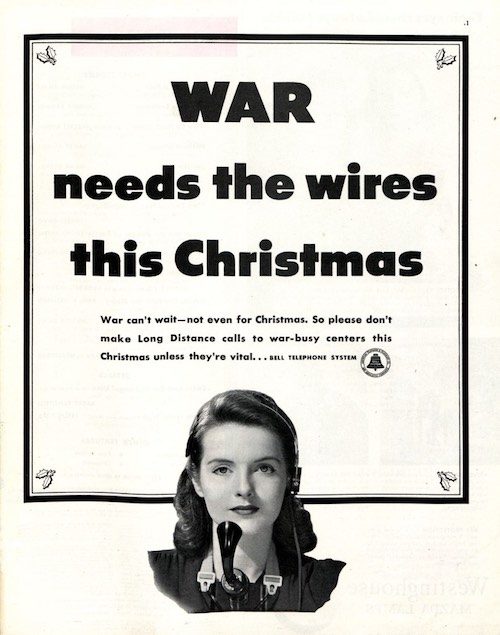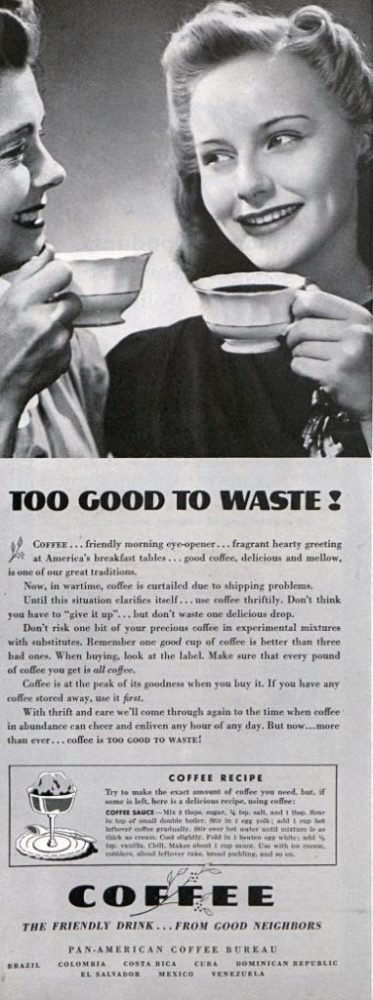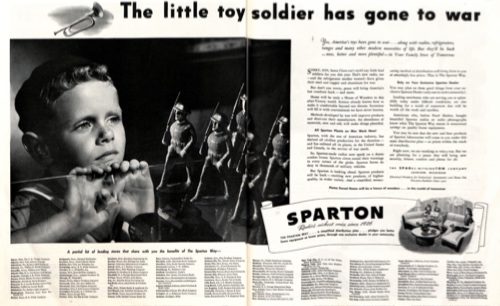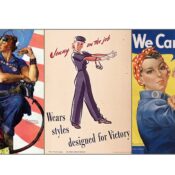1942 would have been a great Christmas, if it hadn’t been for the war.
Unemployment had dropped to 4%. Just nine years earlier it had been 25%, and the average annual income was $5,133. Now it was $9,900. And with the demand for workers in defense plants, many women had become breadwinners, supplying households with two paychecks for the first time.
Americans had never seen such prosperity. But of course, any pleasure they might have felt was dimmed by their worries about the war, and about relatives and friends whose lives were at risk every day.
Moreover, despite the economic boom, the holiday season was affected by new shortages. Ironically, a generation where many had grown up impoverished now had the money to buy the food and luxuries they wanted — but much of what they wanted was in short supply, rationed, or just not being sold.

Click to Enlarge
Here were a few items people had to go without:
Christmas cookies
Butter was in short supply and sugar rationing limited consumers to a pound of sugar every other week, which cut into Christmas treats.
Cigarettes
In 1942, the average American smoked a pack of cigarettes a day. But now a third of American cigarettes had been requisitioned by the armed forces. Smokers were often confronted with “No Cigarettes” signs in stores.
Coffee
The Office of War Production began coffee rationing in November of 1942. Americans could only purchase one pound of coffee every five weeks. For some, this was a third of their normal intake. And this was in a time when average coffee consumption was twice what it is today.

Click to Enlarge
Food
Consumers could only buy 2.5 pounds of red meat per week. Turkey, being a white meat, wasn’t rationed, but could be hard to find since the military requisitioned most of the country’s supply to provide turkey dinners for Christmas. In fact, because of hoarding, stores had trouble keeping all sorts of food, even items that weren’t rationed, available. Some stores themselves began rationing canned goods to prevent hoarding.
Travel
Starting in December of 1942, most motorists could only buy four gallons of gas a week. That limited family travel to approximately 68 miles a week, which might not have gotten them to Grandma’s and back at Christmas. People could still travel by train, but seats were limited because the railroads gave priority to military personnel.
Gifts
Store shelves weren’t exactly crowded that Christmas season. The big names in watches, radios, and other appliances were mostly producing military equipment. Other manufacturers could only get enough metal for limited production of gift items. Even simple items like bobby pins were hard to find. Consumers couldn’t even buy metallic tubes of toothpaste without first returning their old tube. Paper was also limited, which meant fewer books and magazines. Even clothing was in short supply. To conserve fabric, the War Production Board prohibited the sale of pleated skirts for women and double-breasted suits and vests for men.
Toys
Toymakers couldn’t obtain the metal and rubber they normally used, so they improvised. They made dolls, trucks, airplanes, and construction sets from cardboard, or experimented with the new plastics. The Treasury Department acknowledged the toy shortage, but recommended that parents buy their kids War Bonds, which were, of course, in plentiful supply. Many parents made toys out of household materials, or cleaned up recycled toys shared by other parents.

Click to Enlarge
But Americans adapted to shortages. They found renewed pleasure in crossword puzzles, cooking, and parlor games. Women revived their sewing and dressmaking skills. As one historian wrote, Americans of 1942 “got to know their neighbors better. Social life improved noticeably. Pleasures became simpler and less frantic.”
Become a Saturday Evening Post member and enjoy unlimited access. Subscribe now



